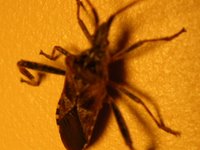
This picture is of a small butternut tree growing about 300 metres (~1000 ft) from the house. On the ground to the right is a bare patch that I believe is created by the butternut root’s characteristic of transmitting the juglone toxin to neighbouring tree roots thus limiting their growth. Only shallow rooted plants such as grass will grow in this area that do not contact the roots. To the left it is also clear. The branches on the ground are left over from a Manitoba maple that was felled and limbed just before the snow fell.


